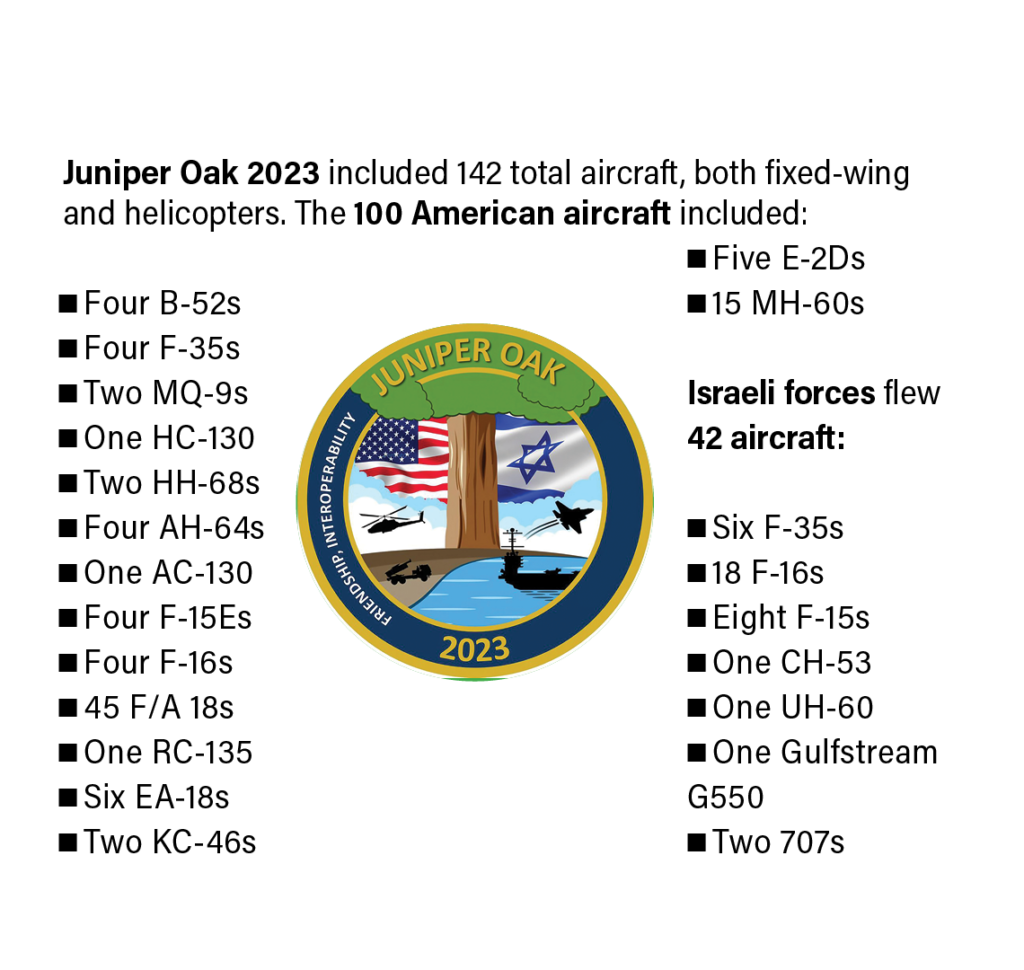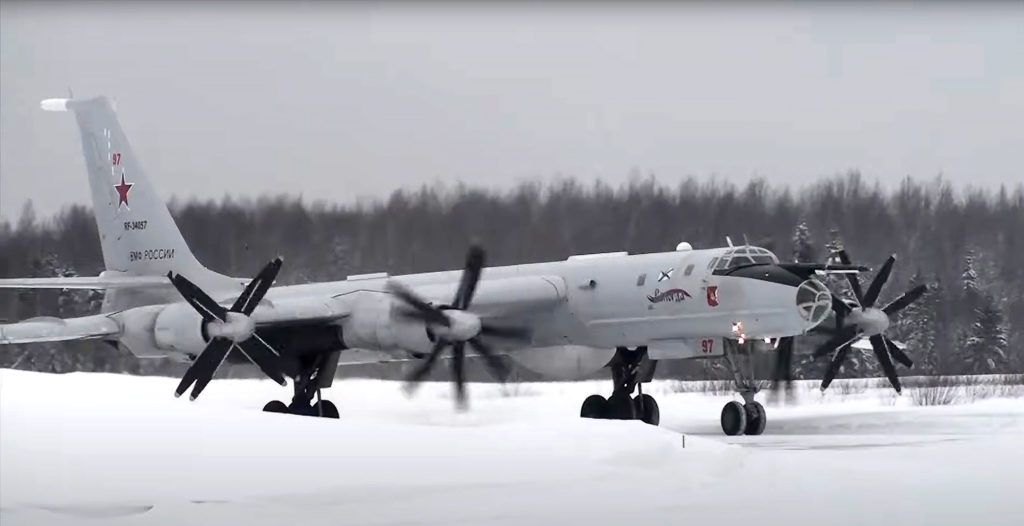US, Israel Kick off Massive Exercise with 142 Aircraft
By Chris Gordon
T
he U.S. and Israel kicked off a massive combined weeklong military exercise Jan. 23, the largest since Israel was moved to U.S. Central Command’s area of responsibility in 2021.
U.S. officials told Air & Space Forces Magazine the exercise, dubbed Juniper Oak, was notable in both size and scope. CENTCOM said everything from space assets, a carrier strike group, strategic bombers, stealth fighters, electronic warfare aircraft, Special Operations forces, and crews operating HIMARS precision artillery launchers would drill in a “combined joint all-domain exercise.”
The exercise ran from Jan. 23 to 27 and involved 180,000 pounds of live munitions and 6,400 U.S. personnel, 450 of which were on the ground in Israel. Operations will took place in Israel and the Eastern Mediterranean Sea.
The exercise “underscores our commitment to the Middle East,” CENTCOM Commander Gen. Michael “Erik” Kurilla said in a statement.
“No country in the world can bring this level of combat power, with such agility into a region” that is not its primary focus, said Bradley Bowman, a former Army aviator and military expert at the Foundation for Defense of Democracies. “At the same time, it’s important for our adversaries and our allies, frankly, to know that and our partners and everyone in the region to know that.”
The drills mark a significant step toward integrating Israel with U.S. forces in the region. Until late 2021, Israel was considered part of U.S. European Command’s area of responsibility, a somewhat incongruous placement that limited the ability of the two nations to exercise together despite facing some common adversaries, such as Iran. The arrangement reflected older sensitivities among Arab states about cooperating militarily with Israel, but relations have warmed between Israel and some Arab states after the signing of the Abraham Accords.
Just a year and a half later, U.S and Israeli forces are conducting a significant exercise of capabilities that will be used in the Department of Defense’s ambitious joint all-domain command and control (JADC2) concept by practicing operations “on land, in the air, at sea, in space, and in cyberspace,” according to Kurilla.
“We are not leaving the region,” Bowman said. “Exercises like this demonstrate the truth of a sustained, persistent, and serious U.S. military presence in the region.”
Of the 142 aircraft participating, 100 were American, including everything from four Air Force B-52 Stratofortress strategic bombers to four Army AH-64 Apache attack helicopters. The U.S.’ robust air presence also included specialized airborne early warning planes, surveillance assets, and electronic warfare aircraft, such as an Air Force RC-135 reconnaissance plane, Navy E-2D Hawkeyes, and EA-18 Growlers. The George H.W. Bush carrier strike group supported six EA-18s, five E-2Ds, and 45 F/A-18s. The U.S. Air Force sent four fifth-generation F-35s, which are not normally based in the region, joining six F-35s from the Israel Defense Forces.
In addition to its stealth fighters, the U.S. Air Force sent four F-15E Strike Eagles and four F-16 Fighting Falcons, as well as Air Force Special Operations components such as an AC-130 gunship. Israel had 32 fixed-wing fighters who participated.
The Space Force was represented in Juniper Oak, with low- Earth and medium-Earth orbit satellites under the control of the command’s new space component, SPACECENT.
CENTCOM said the focuses of Juniper Oak include combined command and control, maritime air operations, combat search and rescue, electronic warfare, suppression of enemy air defenses, air interdiction, and strike coordination.
The exercise took place amid continued tensions in the region. Iranian-backed militias have launched drone and missile attacks against U.S. forces and allies—a drone attack took place Jan. 20 against the Al Tanf Garrison in southeast Syria, though the U.S. has not formally ascribed responsibility.
Iran has also alarmed the U.S. by providing drones to Russia for Moscow’s attacks in Ukraine and has exceeded the limits of the 2015 accord limiting its nuclear program. National Security Adviser Jake Sullivan traveled to Israel from Jan. 18 to Jan. 20 to discuss a range of issues, including Iran’s continued threats in the region, according to the White House.
In a statement, Kurilla said the exercise “enhances our ability to respond to contingencies.”
Juniper Oak included 142 total aircraft, both fixed-wing and helicopters. The exercise included six U.S. ships, including the USS George H.W. Bush, its air wing, and cruisers and destroyers. Six Israeli ships also participated.
Four HIMARS launchers provided long-range precision fire from the ground.
All told, 7,580 personnel participated, including 6,400 Americans, 450 of which are in Israel. Israeli forces involved in the drills number 1,180.
Report: Despite Losses in Ukraine, Russia Remains a Threat in the Arctic
By Chris Gordon
American and Western officials have grown increasingly concerned about Arctic security and Russia’s threat to the region, and even as the Russian military has been degraded by its losses in Ukraine, its Arctic forces remain strong, according to a new report from the Center for Strategic and International Studies (CSIS).
Russia has faced heavy attrition of its ground forces in Ukraine, forcing Moscow to order the conscription of hundreds of thousands of new soldiers, but “the toll from the Ukraine war is not necessarily reflected in the other service branches in the Russian Arctic,” according to the CSIS report.
“The naval components of Russia’s Northern Fleet, particularly its strategic submarine fleet, continue to give Moscow a credible second-strike capability,” report authors Colin Wall and Njord Wegge write, referring to Russia’s ability to launch military attacks from the region.
Russian strategic bombers have been able to operate over Russian airspace unfettered and attack Ukraine with standoff weapons. U.S. military officials have watched the situation with concern, including the commander of North American Aerospace Defense Command (NORAD) and U.S. Northern Command (NORTHCOM) Air Force Gen. Glen D. VanHerck.
“They can take off over Russian air bases today and launch their cruise missiles from over Russia and attack almost all of North America, including the United States of America,” VanHerck said in October.
The U.S. relies on its deterrence capabilities including its nuclear arsenal to prevent attacks on the homeland. Experts have argued America needs a more comprehensive approach to combat missile attacks on the U.S. homeland. The U.S. Missile Defense Review, released in late October, acknowledged that America must better protect itself against various missile threats.
The Biden administration’s Arctic Strategy, which was also released in October, is clear that the region is growing in its strategic importance to U.S. security.
“We will deter threats to the U.S. homeland and our allies by enhancing the capabilities required to defend our interests in the Arctic,” the Arctic Strategy states.
In response to Russia’s war in Ukraine, Sweden and Finland have applied to join NATO and would join Norway as countries in the alliance with a significant presence in the Arctic. But Russia also has major interests and a large footprint in the Arctic, which is home to rich natural resources and the Northern Sea Route shipping channel in Russia’s exclusive economic zone.
“There’s no sign that Russia intends to slow down or stop these projects,” Wall said during a CSIS launch event for the report.
The CSIS report offers recommendations for the Biden administration to help better protect the U.S. and its allies without further militarizing the Arctic.
“There are indirect, light-touch ways to enhance Arctic security: effective imposition of the sanctions regime concerning dual-use computer chips seems to be one way to diminish the conventional Russian threat in the Arctic that does not involve deploying U.S. military assets or personnel to the region,” the report says.
The U.S. has extensive export controls to prevent U.S. technology from fueling Russia’s military arsenal. However, the Royal United Services Institute (RUSI) has examined Russian weapons used in Ukraine and found they make use of U.S. and Western technology and noted that Russia has a variety of ways to acquire such technology, such as front companies.
“These are fielded on Arctic assets,” Wall said.
Despite current U.S. sanctions, Russia’s previous technological development poses an issue, which VanHerck has often highlighted.
While the CSIS experts cautioned against escalating tensions in the Arctic, they also acknowledged a need for NATO and the U.S. to bolster their presence in the region. The U.S. recently activated the 11th Airborne Division in Alaska and the Marines routinely conduct Arctic training. NORTHCOM also hosts a biennial defense exercise known as Arctic Edge, which includes the use of Air Force aircraft.
“I think there is a need on the U.S. side to rebuild some of this institutional knowledge that you had during the Cold War that you are capable of actually deploying there,” Wagge said.


